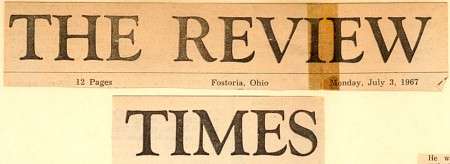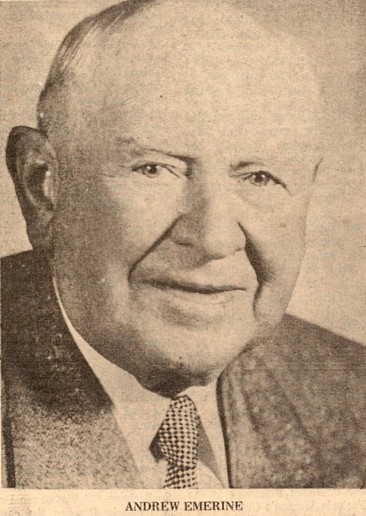|

THE REVIEW TIMES. Fostoria Ohio, Monday July 3, 1967
Was Dean Of Ohio
Bankers
Andrew Emerine, 94,
Claimed Early Today
BY HARRY STONEBERGER
Andrew Emerine,
94, dean of Ohio bankers and former chairman of the board of the Tri-County
National Bank and of the Seneca Radio Corporation, died at 8 a. m. today,
July 3, 1967 at the Villa Maria Guest House at Green Springs, where he had
been a guest for more than a year.

His long career in banking started in 1891 when he was employed as a
collector for the First National Bank of Fostoria which had been organized
by his father, Andrew Emerine, Sr., in 1882. His salary was $30 a month and
his duties included collecting sight drafts from merchants along Main St.,
few of whom had checking accounts.
His radio career started in 1949 when
he purchased the FM station operated by Lawrence Harry. Under his guidance
the station became WFOB-AM and FM, and went on the air in December 1952 at
its present location on Kill Deer Hill, south of Fostoria on U.S. Route 23.
The bank had been organized by his
father, Andrew Emerine Sr., with an authorized capital of $50,000 of which
$25,000 was paid in. His father, the past president, remained inactive
charge of the bank for 41 years. Upon his retirement in 1923, his son became
the president and remained in this post until 1952, when he became chairman
of the board and his son-in-law, Eldren Layton, who joined the bank in 1937,
became president.
The bank, originally located at 110
N. Main St., moved into the Emerine Building at Center and Main Sts., the
present location of the S. S. Kresge Store where it remained until 1933 when
it moved into the present quarters, which had been occupied by the old Union
National Bank.
The bank during the first few years
did a very modest business and all correspondence and accounting was done by
pen and ink. It weathered the money panic of 1893 and assisted many of the
newer business in Fostoria in keeping with banking practices at the time.
In 1887, natural gas was found in the
Fostoria area and this attracted glass manufacturing plants into the
village. At one time seven glass plants were located here. These included
the world-famous Fostoria Glass which later moved to West Virginia when the
gas supply was exhausted.
The promotion of the younger Emerine
to the vice presidency brought much new business to the bank. He had been
managing several farms while serving in a lesser capacity at the bank.
He was elected bank president in 1923
and a year later his father died at the age of 94.
He had served his apprenticeship as
president of the First National Bank of North Baltimore from 1917 to 1920.
He also was president of the Croghan National Bank and Savings Co., at
Fremont from January 1933 to January 1934.
He won national recognition as a
collector of mechanical bands and was the subject of articles in two
national magazines. The first article appeared in the old Liberty Magazine.
A later article in the Saturday Evening Post was titled "The Sorcerer of
Fostoria."
Mechanical banks manufactured around
the turn of the century and were valued according to the scarcity. Some of
his banks were valued in excess of $1,000. His collection was rated as one
of the five most valuable in the world and was listed in the American
Automobile Association's guide as an attraction in Fostoria.
The banks were housed in a museum he
established on the mezzanine floor of the First National Bank.
Another feature of his museum
was a fine collection of antique firearms, including flintlocks, derringers,
pepper-boxes, wheel-locks, match-locks, Colts, pistols of from one to five
barrels, cane guns and whale guns. The collection was assembled over a
period of more than 35 years.
The bank collection was sold some
time ago to a representative of the Mosler Safe Co., manufacturers of bank
vaults and heavy-type safes.
During his long career in
banking the First National Bank established branch banks in Tiffin, Bradner,
Risingsun, Bloomdale and one on N. County Line St.
Operating in three counties the
bank's name was changed to the Tri-County National Bank.
He was interested in Fremont's
history and had 30 replicas made of Old Betsy, a muzzle-loading cannon used
by Major Croghan in defense of the area against the British and Indians. One
was presented to the Birehard Library and another to the Hayes Memorial.
He often said his most exciting
experience in the banking business was when his bank was robbed by the
notorious bank bandits and outlaws, John Dillinger and Homer Van Meter in
1934.
The bandits entered the bank with
topcoats covering sub machine guns. They announced their intentions and
ordered the bank personnel to line up in front of the bank counters. Mr.
Emerine was a little slow in lining up and Dillinger grabbed him and forced
him into the line. Mr. Emerine's shirt was torn by the force.
The bandits started to leave by the
Main St., door with bank personnel protecting them from a crowd that had
assembled. They returned to the bank lobby and left through the W. Tiffin
St., door of the drug store.
Police Chief Frank P. Culp was
seriously wounded by the bandits when he entered the bank lobby to shoot it
out with them.
The bandits stole $13,990 in the
robbery. The money was not recovered but the insurance company paid the
bank's loss within a week.
The babdits fired several shots in
the street and Dillinger rested his machine gun on Mr. Emerine's shoulder
while firing.
The bank was one of the few that
defied Roosevelt's Bank Holiday in 1933.
Knowing his bank was sound and had
plenty of cash on hand, Mr. Emerine kept it open and advised all depositors
that the bank was ready to transact any and all banking business. He said
many depositors withdrew their money and then placed it in a safety deposit
box in the same bank.
During his ling banking career he
acted as financial advisor to thousands of Fostoria area citizens and his
advise helped many small businessmen to weather the money panic in 1907, the
hectic period of 1920-29 and the depression of 1933.
Many Fostoria businesses of today got
their start through conservative loans and advice made by Mr. Emerine and
his advice extended to other bankers in the area. His interest in the bank
was sold, June 1966 to Fostoria Corp.
At the 1966 annual meeting of Group 3
of the Ohio Bankers Association he was honored for his "75 years of devoted
service to banking."
He was civic-minded and participated
in various city activities including fund drives and was a contributor of
all fund drives. His name usually was first on subscription lists and his
activities included the Boy's Village at Smithville.
He was a member of the United
Commercial Travelers and served on its board for many years. He was also a
member of the Elks Club, Demar's Hunting and Fishing Club at Fremont and
served as its president, the Catawba Cliff Club, the Mechanical Bank
Collectors of America, the Fostoria Area Chamber of Commerce, and the
Fostoria Country Club.
He was a member of the First
Presbyterian Church.
He was born in Fostoria Dec. 17,
1873, the son of Mr. and Mrs. Andrew Emerine. His father was an apprenticed
harness maker and broker before he and a few associates organized the First
National Bank of Fostoria.
Mr. Emerine was married twice. His
first wife was Miss Bessie Lepard. Following her death, he was married to
Miss Lucy Dewey of Clyde. His second wife died in August 1964.
In 1962, in an interview taped by
Lyman Carr. Mr Emerine described his two marriages as "the most pleasant any
man ever experienced."
He is survived by a daughter, Mrs.
Jane Emerine Layton, and two granddaughters, Nancy Layton, Evanston, Ill.,
and Mrs. Susan Layton Brown, Battle Creek, Mich.
Services will be Wednesday at 3 p.m.
in the Mann Funeral Home with the Rev. F. Richard Sinclair officiating.
Burial will be in Fountain Cemetery.
Friends may call at the funeral home
from 3 to 5 and 7 to 9 p.m. Tuesday. The family requests that in lieu of
flowers memorials be made to the Cancer or Heart Funds or to the Fostoria
Woman's Club.
Elks services will be at 8 p.m.
Tuesday in the funeral home.
|


